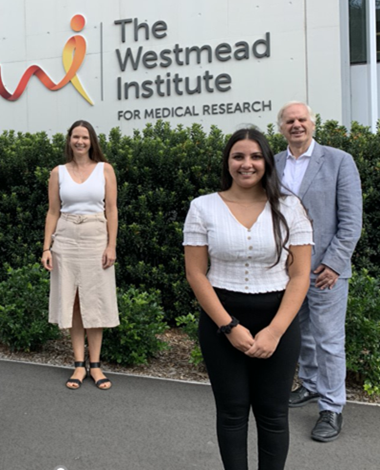May 23, 2022 Print
Congratulations to Dr. Kerrie Sandgren for the outstanding result of being awarded a Fellowship in the prestigious, Moderna Global Fellowship Program. Kerrie is a Senior Research Scientist, co-leading the Vaccine and Adjuvant Research Group in the Centre for Virus Research (CVR) with Professor Tony Cunningham AO.
The goal of the Moderna Global Fellowship program is to support the next generation of scientists and healthcare professionals as they innovate in the field of mRNA research towards improving patient care and population health. Prospective fellows may be clinicians and scientists who are interested in advancing mRNA research and innovation and the program underpins Moderna’s commitment to supporting independent research. Kerrie was selected from a very large and highly competitive pool of global applicants.
Professor Tony Cunningham AO applied as CI with Professor Arnaud Didierlaurent from the University of Geneva as coCI for the fellowship, with Kerrie Sandgren as the nominated fellow, to link the respective programs on mRNA vaccine mechanism of action in human lymph nodes with Arnaud’s mouse model and were successful.
The successful team’s submission is based on elucidating the way in which RNA vaccines work is likely to assist in improving their efficacy and side effects, such as sore swollen arms and fever, muscle aches and fatigue. After injection into the shoulder muscle the vaccine components are rapidly transported to lymph glands in the armpit. Here they stimulate a complex cascade of immune responses which result in the production of key immune defensive cells and antibodies. We aim to decipher the sequence of immune events in the lymph glands using a unique human model applying the Moderna vaccine to lymph gland slices grown in 'the test tube'.
Normal human lymph glands are obtained from patients undergoing dissection of their glands during breast cancer surgery. One extra normal gland is taken after informed consent of the patient. The results will be matched with those in mouse models. Discarded surgical specimens of human muscle will be treated similarly to examine the very first changes after intramuscular injection. Working closely with our collaborators at the University of Geneva, mice, as models, will be injected intramuscularly and immune events in the muscle and lymph node following injection will be determined and compared to the human studies. We will also study samples from vaccinated individuals to validate some of our findings.
The object of these experiments is to determine how closely such mouse models can inform how the vaccine works when injected into the arm of vaccinated human subjects. We expect these results to facilitate the development of novel generation vaccines.

This is a wonderful global collaboration between WIMR, the University of Sydney and The University of Geneva, we wish Kerrie, Tony and team every success with the research program and look forward to providing updates along the journey.
Pictured from left: Kerrie Sandgren, Vicki Stylianou, Tony Cunningham
Not shown:
Liz Dunn, Yu Na Chung